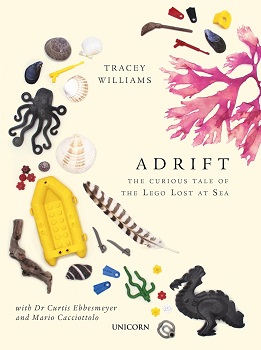Adrift: the Curious Tale of the Lego Lost at Sea by Tracey Williams
For some, summer days spent along Washington’s rocky shores conjure up memories of kite flying, flipping rocks to startle baby crabs, and beachcombing. The joy of finding the occasional shell or sand dollar, a piece of interesting driftwood or the ultimate prize – sea glass – is as linked in our minds as the briny smell of the ocean, the crunch of barnacles beneath our feet, and the shrieks of seagulls.
Some collect agates, or friendship rocks, or stones with question marks on them. Author Tracey Williams has another target: Lego. In Adrift: the Curious Tale of the Lego Lost at Sea, Williams takes us on “a voyage into the changing nature of beachcombing, dragon hunting, plastic in the sea and sand, and the lasting legacy of a cargo spill.”
So, why Lego? As a child, Williams loved family beach holidays in Cornwall, England. Then, in 1997, the cargo vessel Tokio Express lost sixty-two containers during a violent storm off the south coast of Cornwall. One of those containers held nearly 5 million Lego pieces, which began washing up on the shores of Devon beaches. That they happened to be sea-themed made it more delightful – 97,500 tiny scuba tanks, 79,600 mini spear guns, and thousands of others.
Some of the most prized were dragons – 33,427 black ones and 514 green ones, scooped up by eager children and coveted by others. Dragon hunting captured the imagination and became an obsession for many including Williams, with black octopuses being another favorite.
Soon after the spill, news reached renowned oceanographer Dr. Curtis Ebbesmyer, a researcher known for tracking the movement of flotsam such as ice hockey gloves and rubber duckies. He was able to obtain a shipping manifest from Lego and a box of samples of the various pieces that went down with the Tokio Express. He conducted tests on which pieces floated, and started making predictions about where the pieces would wind up based on global currents and weather patterns.
Williams uses the Tokio Express event as a starting place to explore the increasing problem of plastic pollution in our world’s oceans. In 2018, she notes, a plastic bag was identified at the bottom of the Mariana Trench. Flotsam and jetsam from shipping containers is only one source – but a significant one.
Williams details several famous cargo spills, like a container of bright orange Garfield the Cat telephones, another of pink detergent bottles, and thousands of running shoes and My Little Pony dolls. Williams is both amazed and horrified by the variety and sheer volume of things that wash up on beaches. She provides a lengthy list of organizations that work to address marine pollution and conservation.
This petite tome measures 6 inches by 8 inches, perfect to slip into a beach bag so you can dip into it while leaned against a driftwood log on Clayton Beach or in a sand chair perched along Birch Bay. It’s loaded with watercolor illustrations, colorful photographs, maps, poems, and even a scavenger hunt list of items to find within the book.
Overall, Adrift seems like a miraculous little gem that just appeared out of nowhere to surprise and delight readers, just like a treasure washed up on the beach.
Christine Perkins is executive director of the Whatcom County Library System, wcls.org.
(Originally published in Cascadia Daily News, Thursday, July 4, 2024.)

